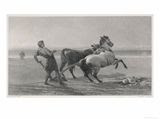Visual communications can transmit messages using pictures or text. Handwritten text represents a unique creation, as the letters that make up the words are never written exactly the same way twice even when composed by the same author.
All electronically written text is created using one or more typefaces, or fonts. Encarta Dictionary defines the word "Font" as “a full set of printing type or of printed or screen characters of the same design and size.”
Font style is chosen to convey a particular type of message and type choice can have a big effect on the way an audience understands that message. To get an idea of some of the finer points of choosing a type, with a little typography history thrown into the mix, take a look at the following movie clip on Font Design:
In order to explore the topic of font style in more depth, I have selected one particular font type to focus attention on, and the font I have chosen to profile for this posting is: MONGOLIAN BAITI.

Mongolian Baiti is licensed by Microsoft Corporation and is available in Windows Vista and Windows 7.

Using Kathleen Burke Yoshida's excellent advice put forth in her publication
"Avoiding Typeface Terrors", let us take a look at Mongolian Baiti as compared to the font Tahoma in a real-life comparison of a conventional headline for an international company in the shipping industry. In this example, the company, CaroTrans, designed their website using Tahoma for the headings and sub-headings. I have provided a sample of CaroTrans' sub-heading, using Tahoma with a sample sub-heading using Mongolian Baiti:
Using this example, it is clear to see that Tahoma is a better choice for a title heading for an international company that depicts stability and strength, while Mongolian Baiti could provide good suitability and readability for the body of the text, and could easily be used with equal effect instead of a type like Arial or Times New Roman. In this example, we note that Mongolian Baiti does meet the standard definition of good legibilty, as the text is easy to read even after it is divided into top and bottom halves.
In continuing our analysis of typeface suitability, there are six important points to consider when selecting a font:
Do I use serif or sans serif type?
Is the typeface legible?
How is the readability of the font? Is it easy to read or should it only be used for dramatic effect?
What is the font's personality?
And most importantly, who is my audience and what message do I want to convey?
Serif or sans Serif - Typography experts such as Yoshida tell us that Serif type lets the reader easily follow the type across a long line of text, as it creates a baseline for the eye to follow. Mongolian Baiti is a serif style of type, making it a good choice for body text.
Legibility - How easy is it to recognize letters? - Yoshida tells us we can test legibility by placing a piece of paper over either the top or bottom half of the letters. If the text is still easy to read, the font is considered legible.

Readability - The x-height of Mongolian Baiti contains letters that have a larger body than the ascenders and descenders, making it a good choice type for easy reading, similar to Times New Roman in its versatility.
(See comparison of Times New Roman body text with Mongolian Baiti)

Personality
Yoshida tells us that a typeface's personality is related to certain characteristics of the letters,but it also depends on the subjective view of the reader. Mongolian Baiti has the feel of a understated conventional type with just a small amount of flair. The negative personality qualities of Mongolian Baiti is its lack of uniqueness and lack of distinction from other related type styles, such as Times New Roman. The positive impressions conveyed by Mongolian Baiti are the qualities of calmness, reliability, authority, and trust. Mongolian Baiti says "you can believe me - what I say in this type is true."
Compare this trustworthiness of Mongolian Baiti's personality with the typefaces of WaltDisneyScript and Candy Round BTN - Which one would you believe more?

For a humorous look behind the personalities of type, I hope you will enjoy a little type parody, as presented in the next video clip, Font Conference:


Great article. A lot of good information
ReplyDeleteGreat article. A lot of good information
ReplyDelete